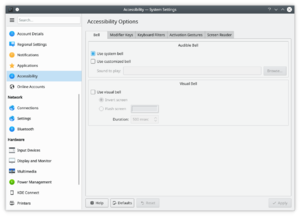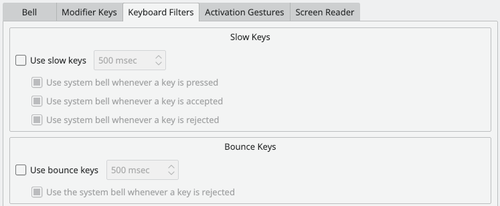System Settings/Accessibility/fr: Difference between revisions
ChristianW (talk | contribs) Created page with "{|class="tablecenter vertical-centered" |300px|thumb|center |Paramètres pour améliorer l'utilisation du bureau pour les personnes défi..." |
ChristianW (talk | contribs) Created page with "{{Info/fr|1=Si vous avez activé les effets du bureau, vous trouverez quelques options qui peuvent être intéressantes dans le module Special:myLanguage/System Settings/Des..." |
||
| Line 9: | Line 9: | ||
Plasma contient des paramètres d'accessibilité pour facilter l'utilisation de votre ordinateur. | Plasma contient des paramètres d'accessibilité pour facilter l'utilisation de votre ordinateur. | ||
{{Info|1= | {{Info/fr|1=Si vous avez activé les effets du bureau, vous trouverez quelques options qui peuvent être intéressantes dans le module [[Special:myLanguage/System Settings/Desktop Effects|Effets du bureau]] de '''Paramètres système'''.}} | ||
== Cloche == | == Cloche == | ||
Revision as of 11:52, 29 November 2018
 |
Paramètres pour améliorer l'utilisation du bureau pour les personnes déficientes |
Plasma contient des paramètres d'accessibilité pour facilter l'utilisation de votre ordinateur.
Cloche

In the tab you can customize the system bell. The visible bell settings allows you to change their preferences to having a visual notification on the screen. For example, if a document is being edited, and a sticky key is pressed, you can choose between having the document's interface window being color-inverted, or having the entire window screen of the document change to a custom user-selected color.
The slider allows you to select how long the active window will change color in milliseconds. A smaller amount of time will mean there will be a shorter pause in between visible bells, while a larger amount of time means that the visible pause will be longer.
If you find these settings useful, you may also want to have a look at the Application and System Notifications module of System Settings.
If you find it difficult to use the keyboard, the and tabs have options that you may find helpful; and the has options to use mouse gestures to activate sticky keys or slow keys, if you do not want to use these features all the time.
Modifier Keys

There are two panels here, the Sticky Keys and the Locking Keys panel. Sticky keys is a setting to make it easier to enter multiple key shortcuts. For instance, when one wants to capitalize a letter, the Shift key is pressed at the same time as the letter. Sticky Keys allow you to first press Shift, Control, or Alt, and then release it and press another key. This system will interpret it as those keys being simultaneously pressed.
There are 3 Locking Keys on most keyboards. These keys are the Caps Lock, Num Lock, and Scroll Lock keys. In the tab, you can choose to have a system bell played if these are activated or deactivated.
Filtres clavier

Slow Keys
Slow Keys allow confirmation that a key has been pressed and entered. The system bell is activated when the time allotted with the slider has passed. For a key to be accepted, it has to be held until the set amount of time. The system bell can be used to indicate when a key press has been made, accepted, rejected, or any combination of the three.
Bounce Keys
The bounce key setting is used to prevent multiple characters appearing in a document as a result of an immediate key press occurring after the first one. If you press a key again in less time that has been set with the slider, the second repeat character won't be made and a system bell might activate.
Even simple settings like slowing the rate of keyboard repeat can be a great help
Activation Gestures

Lecteur d'écran



